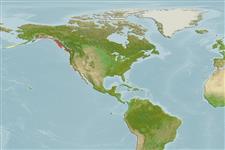Common names from other countries
Environment: milieu / climate zone / depth range / distribution range
Écologie
; profondeur 0 - 15 m (Ref. 1745). Boreal
Eastern Pacific. Boreal to subtropical.
Length at first maturity / Taille / Poids / Âge
Maturity: Lm ? range ? - ? cm Max length : 10.0 cm COLD mâle / non sexé; (Ref. 865)
Minimum depth from Ref. 865. Found in rocky intertidal and low intertidal areas (Refs. 1745, 865). Colonial (Ref. 2268).
Life cycle and mating behavior
Maturité | Reproduction | Frai | Œufs | Fécondité | Larves
Members of the class Ascidiacea are hermaphroditic; both cross- and self-fertilization is typical. Life cycle: Eggs develop into lecithotrophic larva before metamorphosing into benthic adults.
Lambert, G. and K. Sanamyan. 2001. (Ref. 1745)
Statut dans la liste rouge de l'IUCN (Ref. 130435)
statut CITES (Ref. 108899)
Not Evaluated
Not Evaluated
Utilisations par l'homme
| FishSource |
Outils
Plus d'informations
Taille/ÂgeCroissanceLongueur-poidsLongueur-longueurMorphologieLarvesAbondance
Sources Internet
Estimates based on models
Preferred temperature
(Ref.
115969): 6 - 15.9, mean 9.1 (based on 369 cells).
Catégorie de prix
Unknown.
